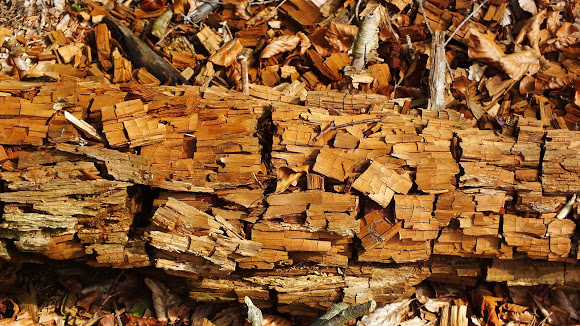7 wood choices for woodworking beginners
How to avoid a slippery deck?
8 Woodworking Tips and Tricks For Beginners
Woodworking Ideas: Tips and Tricks Useful to Jumpstart Any Woodworking Project
Wood-decay fungus
Brown rot
A wood-decay fungus is any species of fungus that digests moist wood, causing it to rot. Some species of wood-decay fungi attack dead wood, such as brown rot, and some are parasitic and colonize living trees. Excessive moisture in wood is required for fungal colonization and proliferation. Fungi that not only grow on wood but permeate its fibrous structure and actually cause decay, are called lignicolous fungi. In nature, this process serves to break down complex molecules and return nutrients to the soil. Various lignicolous fungi consume wood in various ways; for example, some attack the carbohydrates in wood and some others decay lignin (structural materials in the support tissues of vascular plants). The rate of decay of wooden materials in various climates can be estimated by empirical models.
Wood-decay fungi can be classified according to the type of decay that they cause. The best-known types are brown rot, soft rot, and white rot. Each produce different enzymes, can degrade different plant materials, and can colonize different environmental niches.
Brown-rot fungi break down hemicellulose and cellulose that form the wood structure. In this type of decay, the wood shrinks, shows a brown discoloration, and cracks into roughly cubical pieces, a phenomenon termed cubical fracture. Brown-rot fungi of particular economic importance (3 main fungi) may attack timber in buildings. Dry rot is a generic name for certain species of brown-rot fungi.
There are very few brown rot fungi in tropical climates.
Soft-rot fungi leads to the formation of microscopic cavities inside the wood, and sometimes to a discoloration and cracking pattern similar to brown rot.
Soft-rot fungi are able to colonize conditions that are too hot, cold or wet for brown or white-rot to inhabit. They can also decompose woods with high levels of compounds that are resistant to biological attack. Bark in woody plants contains a high concentration of tannin, which is difficult for fungi to decompose, and suberin (waterproofing waxy substance) which may act as a microbial barrier.
White rots break down lignin and cellulose and commonly cause rotted wood to feel moist, soft, spongy, or stringy and appear white or yellow. There are many different enzymes that are involved in the decay of wood by white-rot fungi. White-rot fungi are grown all over the world as a source of food – for example the shiitake mushroom, which in 2003 comprised approximately 25% of total mushroom production.
Source wikipedia
Wooden floors have a timeless quality
Wooden floors have a timeless quality that can change the whole look and feel of a building. We all love wooden floors, but what do we need to be aware of when shopping for flooring to get the best results?
Living in the wet tropics, one of the main considerations we need to be mindful of is the effects of moisture on wood in our construction. Wood floors are no exception. All wood has a moisture rating which changes as the temperature and moisture in the air increases and decreases with the seasons. Wood is a natural product so it expands and contracts in response to these changes.
The general and very simple rule of thumb with wood flooring is never put solid wood flooring in wet or moisture-susceptible areas: water and wood do not mix. This includes in areas that are below grade such as basements or cellars. Water degrades wood, and constant or prolonged expose can cause cracks, cupping and buckling.
The method you use for floor installation will depend on how and where you are installing your floor. The three common installation sites are described as below grade, on grade or above grade. For floors at the on-grade or ground level, it is common to nail or screw the boards onto small battens which have been nailed or screwed into a concrete subfloor. This is all fine, but remembers to seal your concrete slab with plastic sheeting first to prevent the enemy of the wood floor, rising damp. Just like we can take steps to build out termites, we can also take steps to eliminate moisture intrusion. Sealing your concrete slab should be a standard building practice in the wet tropics, but unfortunately this is not the case hence you will need to request this specifically.
For floors at the above grade level, commonly the flooring will rest on floor joists which are sitting on bigger beams known as bearers. A floor that rests on joists as opposed to on battens or one that is glued directly onto the floor is known as a ‘floating floor’. It is a good idea to check what kind or structural support you need when shopping for flooring as this cost needs to be calculated to get the final per square meter price.
Some tips on selecting and installing wood floors:
- Ensure your boards finished to an even thickness at a minimum. This will make it a lot easier to install.
- For below and on grade flooring, check the moisture content of the wood prior to installing if possible and make sure there is no possibility of moisture intrusion
- Solid wood flooring shrinks in dry environments and expands in wetter environments and most of the expansion happens along the growth rings (tangentially), and about half as much across the rings (radially). Get flooring which has small grooves on the underside, known as “back relief” to allow for this swelling and shrinkage
- Remember that wide boards tend to expand and contract more than narrow boards
Have fun!


